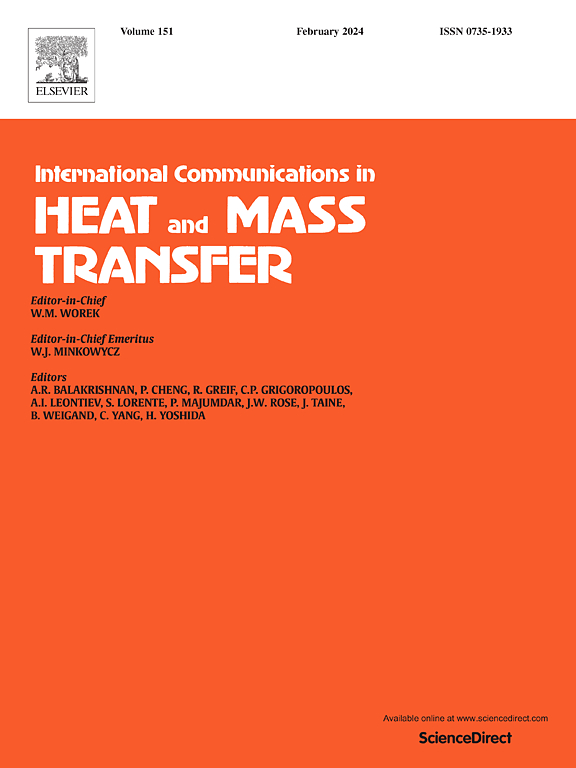用于多芯片元件的多层陶瓷电路基板微系统热管理的集成嵌入式冷却方法
IF 6.4
2区 工程技术
Q1 MECHANICS
International Communications in Heat and Mass Transfer
Pub Date : 2025-05-04
DOI:10.1016/j.icheatmasstransfer.2025.109005
引用次数: 0
摘要
随着多芯片组件高密度集成封装的进步,有效的热管理变得越来越重要。在本文中,我们提出了一个集成的微系统封装设计,旨在通过使用层间微通道歧管来解决高功率多芯片组件的热管理挑战。通过将多芯片组件与嵌入式冷却技术相结合,我们显著降低了热阻,从而实现了紧凑、轻量化和高效的微系统。最初,我们采用高温共烧陶瓷技术将多层电路与流道流形结构集成在一起。在近结区制备了具有多种微通道设计的硅基热测试芯片。随后将陶瓷基板与热测试芯片粘合,以创建一个内聚的多芯片组件。多芯片组件是3毫米厚的集成电路和微流控封装均匀冷却剂分布。为了评估其传热性能,我们构建了一个测量平台,并建立了多芯片组件的仿真模型。分析了非均匀热源分布和不同配置对嵌入式微通道区域的影响。我们的结果表明,模拟预测在设计的流道内最大温差为2 K。实验结果表明,当多片组件的总功率为128 W(热流密度为356 W/cm2),流量为142.8 mL/min时,多片组件的平均温度降低了11℃,热阻降低了34.5%,温度均匀性提高了53.1%。本研究为高功率多芯片组件的热管理策略的未来发展提供了强有力的理论见解。本文章由计算机程序翻译,如有差异,请以英文原文为准。
Integrated embedded cooling method for thermal management in multilayer ceramic circuit substrate microsystems for multi-chip components
With the advancement of high-density integrated packaging for multi-chip components, effective thermal management has become increasingly critical. In this paper, we present an integrated microsystem package design aimed at addressing the thermal management challenges of high-power multi-chip components through the use of interlayer microchannel manifolds. By combining multi-chip components with embedded cooling technology, we significantly reduce thermal resistance, resulting in compact, lightweight, and highly efficient microsystems. Initially, we employed high-temperature co-firing ceramic technology to integrate multilayer circuits with the flow channel manifold structure. Silicon-based thermal test chips featuring various microchannel designs were fabricated in the near-junction area. The ceramic substrate was subsequently bonded with the thermal test chip to create a cohesive multi-chip assembly. The multi-chip component is 3 mm thick with integrated circuitry and microfluidic packaging for uniform coolant distribution. To evaluate heat transfer performance, we constructed a measurement platform and established a simulation model for the multi-chip components. We analyzed the effects of non-uniform heat source distribution and different configurations in the embedded microchannel area region. Our results indicate that the simulation predicts a maximum temperature difference of 2 K within the designed manifold flow channel. Experimental findings demonstrate that when the total power of the multichip components is 128 W (heat flux 356 W/cm2) and the flow rate is 142.8 mL/min, the average temperature of the multichip components is reduced by 11 °C, a decrease in thermal resistance by 34.5 %, and an enhancement in temperature uniformity by 53.1 %. This research provides robust theoretical insights for the future development of thermal management strategies in high-power multi-chip components.
求助全文
通过发布文献求助,成功后即可免费获取论文全文。
去求助
来源期刊
CiteScore
11.00
自引率
10.00%
发文量
648
审稿时长
32 days
期刊介绍:
International Communications in Heat and Mass Transfer serves as a world forum for the rapid dissemination of new ideas, new measurement techniques, preliminary findings of ongoing investigations, discussions, and criticisms in the field of heat and mass transfer. Two types of manuscript will be considered for publication: communications (short reports of new work or discussions of work which has already been published) and summaries (abstracts of reports, theses or manuscripts which are too long for publication in full). Together with its companion publication, International Journal of Heat and Mass Transfer, with which it shares the same Board of Editors, this journal is read by research workers and engineers throughout the world.

 求助内容:
求助内容: 应助结果提醒方式:
应助结果提醒方式:


